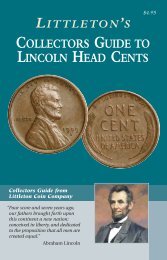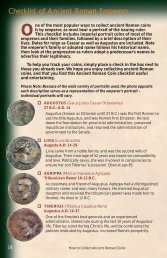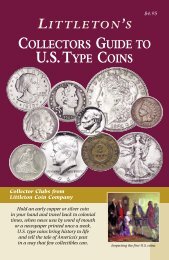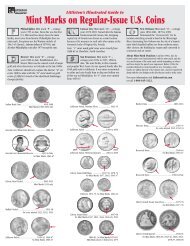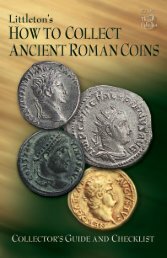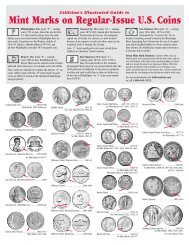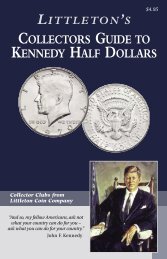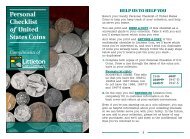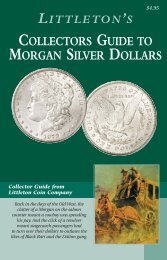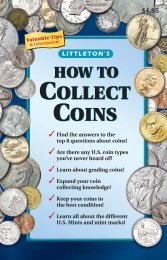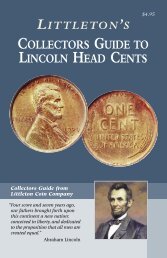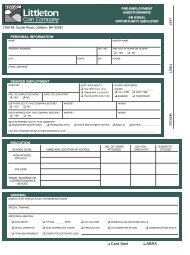Collecting Paper Money - Littleton Coin Company
Collecting Paper Money - Littleton Coin Company
Collecting Paper Money - Littleton Coin Company
Create successful ePaper yourself
Turn your PDF publications into a flip-book with our unique Google optimized e-Paper software.
the history of u.s. paper money<br />
{<br />
10|<br />
at the Spanish colonial mints in Mexico and South America.<br />
Because the Continental Congress authorized their creation, they<br />
became known as Continental Currency. Unfortunately, these notes quickly<br />
depreciated to where the face value was worth less than the paper it was<br />
printed on. This depreciation in value created the popular expression of the<br />
day, “it’s not worth a Continental.” Today, the notes are in great demand by<br />
collectors! After their experience with Continental Currency, Americans were<br />
extremely reluctant to accept paper money issued by our government.<br />
The birth of America’s currency system – 1793<br />
Once the Constitution was ratified, the coinage system of the United States<br />
was established. America’s first coins were struck in 1793 at the Philadelphia<br />
Mint, and from then until 1861 (68 years later), the U.S. government saw no<br />
need for a national paper currency.<br />
But during this period, several important events took place. The War of<br />
1812, the Mexican War of 1846, the Panic of 1857, and the uneasy period<br />
immediately before the outbreak of the Civil War all caused a severe drain on<br />
the U.S. Treasury. To overcome these deficits, the federal government issued<br />
so-called Treasury Notes from time to time. They were simply signed<br />
“promissory notes” which earned interest, and did not circulate as money<br />
except for a brief time in 1815.<br />
Financial ruin and “broken banks” – 1830s-1861<br />
Despite such difficult economic periods, the country continued to grow. It<br />
became apparent that there simply was not enough money in circulation to<br />
meet the ever-increasing needs of daily commerce. In an effort to remedy the<br />
situation, some states gave private banks the right to issue their own<br />
currency. The backing for this currency was the amount of money the bank<br />
had on deposit.<br />
Unfortunately, when times were hard, people failed to pay their loans,<br />
and banks lost their source of income. Without money coming in, banks<br />
literally “went broke” and were forced to close their doors.<br />
Broken Bank Notes often showcase artistic designs.<br />
The currency issued by these ruined banks became known as “Broken<br />
Bank Notes.” Because of their wide range of artistic designs, unusual<br />
denominations, and the oftentimes colorful names of the banks themselves,<br />
these notes are popular collectibles today!<br />
www.littletoncoin.com<br />
{littleton coin company



